The road less travelled
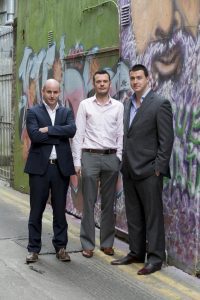
Pat Nolan: As publicans you’ve a different way of doing business and it seems to be paying dividends. It’s worthwhile looking at that. Maybe I’ll start with you, Noel. To me you represent the most obvious case of it when you installed the tank of Pilsner Urquell at the side of the entrance to The Bridge 1859 that’s filled by tanker once a week.
Noel Anderson: Before we opened The Bridge, I spent a week in New York and a week in London looking around at different stuff. I think that’s important. People are looking for something different. It was my manager John who found the tank beer over in London.
So I went over and had a look. I’d worked with Richmond Marketing before so I thought that this was something completely different.
We were the first to bring it into Ireland and remained first for about a year.
I think craft beers are so important to people now and this was a different take on it. It gives customers an opportunity to taste the freshest beer: it’s like tasting beer in the brewery and it’s going down really well. We sell about a tank a week of it which equates to about 880 pints. The glassware and Point Of Sale around it are completely different. I suppose it’s our Unique Selling Point.
PN: Is it acting as a draw for customers to come in?
NA: I think it is. At the start, it created a lot of interest. I think we had most publicans in Dublin coming in, having a nose at it. I didn’t want to be seen as a one-trick pony, so I ‘d come up with something different.
PN: Have you any other unusual items?
NA: We did our cocktail scene a little differently – maybe a bit too differently for some people. But we try as much as possible to come up with different things and you’re always looking around. Yeah, we’ve a good cocktail guy and maybe he pushed the boundaries a little too far. Some of the feedback from the girls might be: don’t change the wheel completely on it… So we pulled back a little on it.
PN: Some of the standard cocktails were a bit too different?
NA: There was some quite creative and innovative stuff but we’ll probably pull back a little on it now and stretch the legs in a couple of years but the tank beer is going extremely well. When you walk in the door, it grabs you. It immediately creates a talking point. The idea was that as soon as they’d come in the door, we’d shock them with something.
PN: Emmet, what’s your Unique Selling Point?
Emmet Lynch: It’s probably more difficult in Tullamore to have a single Unique Selling Point. We have to package a lot of things together but we try to be a community pub as much as possible.
We’ve a function room upstairs and we offer it to the Chamber of Commerce or local residents’ groups or we run Pilates classes from it. The drama group uses it and there’s a rhymers’ group using it too. We offer the space over the pub to whatever a community group wants.
We try to put ourselves in the heart of the community, to know what the community wants and hope that we gain business, parties and events from that. Apart from running Pilates in the pub we’d have a Medium and Clairvoyant now and again, so we’d have pretty random events upstairs and then downstairs we’d follow trends like selling premium spirits. Our cocktail list would probably be one of the better ones in town and we’re following other trends like craft beers.
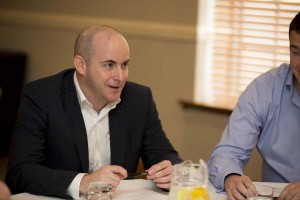
“We try to put ourselves in the heart of the community, to know what the community wants and hope that we gain business, parties and events from that” – Emmet Hughes.
PN: Did you also mention you’d put some money into your coffee section?
EL: Yes, just six weeks ago we converted a mini disco-bar into a café. So we designed it in a kind of vintage style. We’ve started doing food for the first time. We’ve been in business for 45 years and we started doing food about six weeks ago.
PN: Much more labour-intensive…
EL: A lot more labour-intensive. It’s a business I’m just figuring out myself.
NA: You’ll still be figuring it out in 20 years’ time!
EL: The margins on the food seem low: the staff costs are ridiculously high and when you sit down to figure out where’s the money in all of this…
NA: …There isn’t any…
PN : But that’s the draw-in, isn’t it?
EL: What I’ve discovered since we opened is that we caught the end of the Six Nations and a few sporting events and certainly our Saturday day drink sales have increased dramatically.
People are coming in, couples or groups of four or six. They’re having something to eat and then we’re managing to hang on to them and sell pints or wine and they’re staying to watch matches which previously didn’t happen.
So I’m trying to console myself that the pay-off for all this – and all the hassle – is that I’m selling more drink.
NA: Yes there’re a lot of misconceptions about food, that there’s loads of money in food.
PN: Labour costs are astronomical and it’s a thin margin. Aaron, you’re in a very competitive part of town.
Aaron Groom: Our Unique Selling Point would be our opening hours. We run a café during the day so we’d be open from 7.30 in the morning. We don’t serve drink until 2pm in the bar; the bar would be 60% food. We’d sell more coffee than we would draught beer. 30% of our coffee sales would be after six o’clock because we have a cinema next to us and we have about 500 apartments above us and strangely enough we would keep a Barista on right up to 9 pm. I suppose the coffee shop would be our unique side of things.
A lot of people come in during the day. We have the courts all around us and a lot of them wouldn’t even know we’re a pub in the evening and the evening crowd wouldn’t know that we’re a café during the day.
We also sell a lot of the craft beers.
Changing trends
PN: Going back to Noel, what trends have you seen in the last 12 months? Has there been a change?
NA: There has been a change. From the Grafton Lounge model I’ve learned a lot. Monday, Tuesday, Wednesday, in the evening it’s basically people going for a bite to eat and having a couple of drinks. Casual.
But we made The Bridge a lot more food-focused than the Grafton Lounge was. There’s an awful lot of people who will go out Monday, Tuesday, Wednesday and Thursday for a bite to eat and a couple of drinks and then home.
It’s pretty well-documented that for the late-night scene, people are staying at home and going out later. That’s the other trickier side of the town.
The Bridge is more of a pub than the Grafton Lounge: there are similarities but fundamentally they are a lot different.
PN: Are there different consumers in the Grafton Lounge wanting different things?
NA: The unique thing about the Grafton Lounge is that you go in there in the morning for breakfast at nine o’clock, then you go back and you’re into lunch and then you’re into an evening scene and after that into a night bar; it effectively evolves into a nightclub. And then if you come back in the morning you can get a Cappuccino and scrambled eggs. It goes full circle.
The Bridge doesn’t have the late-night scene – I probably enjoy that end of it – it’s a much easier operation to run.
PN: Emmet?
EL: The one trend that I’ve noticed is that there’s certainly an interest in spirits – premium spirits and other spirits.
We’ve a large whiskey selection: we have 70 or 75 Irish whiskeys and customers are interested in talking about those spirits and tasting them. Going back to five or six years ago we had one vodka and one gin, a couple of whiskeys and that was about it. The customer wasn’t that interested in the brand.
Now, with staff training, you can excite customers about particular brands, something that’s slightly different, or a premium product as well. There’s definitely an interest in that, more awareness.
PN: So I presume that there’s more money in people’s pockets if they’re going for premium?
EL: Get something that people are interested in. They mightn’t drink as many but you can start a conversation about whiskey and get someone to spend €7 or €8; they might not drink five or six of them, but they’re interested in trying premium spirits, if you can start the conversation.
PN: Any other trends?
EL: We’ve started to sell a lot of coffee that we never sold before.
PN: That would go with your investment.
NA: Gin is becoming a huge thing now. It started off five years ago, when it was vodka and it turned to rum – an awful lot of Mojitos – and now, all of a sudden, gin is a huge thing. In The Bridge we’re selling a lot of gin.
PN: What’s the majority of it – G&T?
NA: Yes, even the tonics, the different tonics like the elderflower tonics. People are definitely changing it up and there’s a couple of really good gins out there.
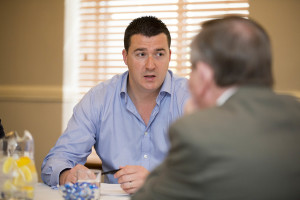
“Gin is becoming a huge thing now. It started off five years ago, when it was vodka and it turned to rum – an awful lot of Mojitos – and now, all of a sudden, gin is a huge thing. In The Bridge we’re selling a lot of gin” – Noel Anderson.
PN: Kevin Redmond in Andy’s Bar & Restaurant in Monaghan tells me that they have no problem selling a premium G&T for €7 or €8 – and that’s well out of Dublin. He says what’s the point in having a premium spirit if you don’t have a premium mixer to go with it?
NA: We have a gin and tonic cocktail; it’s served in one of the big tumbler glasses. It has a wedge of coconut in it and grapefruit; it’s completely different. It just shows you can create a cocktail out of a Gin & Tonic and it flies out the door.
AG: When we opened first, because of our location we were worried about doing drinks promotions. Because of the nature of the bar, it had had a rough kind of element to it. So when we did a promotion we did a €5 Gin & Tonic and we’ve continued it: it’s very successful and hugely popular.
But where I see trends going, it’s definitely casual dining. People want to go out mid-week. It’s not a special occasion. People want good quality affordable food. When we opened up our second premises in Christ Church, we did a formal dining area upstairs and it just didn’t work. We’ve changed it back to follow the trend of the first premises: very casual dining. That seems to be what people want. They don’t want a formal diningroom, they don’t want to be getting dressed-up to go out.

“In Christ Church we’ve had to adapt: certain elements of it didn’t work and you have to make quick decisions to change. If you don’t, you’re dead in the water.” – Aaron Groom. I’d recognise that trend….
PN: I’d recognise that trend….
NA: I’d agree with that big time.
PN: Noel, I’m going to give you an example and I’m going to ask you to advocate why people should go to a pub. My daughter – student over 21 – will get a bottle of vodka with her pals and they’ll polish it off at someone’s house before they head out. They’ll go to the pub for one for appearances sake more than anything else. They’ll go to the nightclub, they’ll get one drink and they’ll go back to somebody’s house for another bottle of spirits. The on-trade is only getting one or two units out of all that and she’s not alone here. Her question to me is: why would we go to a pub?
NA: We try to steer away from that particular market as much as possible. I suppose the pub is a great environment to go and meet people. It’s still the Number One place for boy-meets-girl, a pub or a club.
I think you always get a bit of fun, a bit of craic, that you just can’t get at home.
I still think that the Irish do pubs really well. I go off on stags or weekends away and I reflect back. Dublin would be a great city to visit compared with the experiences we have abroad. I think that what Dublin can offer in bars and restaurants is second to none. You can’t beat the atmosphere in a Dublin pub.

“People want to go out mid-week. It’s not a special occasion. People want good quality affordable food. When we opened up our second premises in Christ Church, we did a formal dining area upstairs and it just didn’t work. We’ve changed it back to follow the trend of the first premises: very casual dining. That seems to be what people want. They don’t want a formal dining room, they don’t want to be getting dressed up to go out” – Aaron Groom.
People do like to go out but they expect a certain standard, so if they’ve got money in your pocket you have to deliver. I’m a big fan of the pub myself. Michael Wright was well-documented in saying that his place was a dance-floor for Tesco. There still is that element.
The young side of things – I’d run a mille. You’d see it with young people; they come up to the counter, two Diet Cokes and you give it 30 seconds and they’re pulling a naggin out of their bag.
PN: You’d see that coming a mile off.
NA: I’d steer away from the young scene altogether.
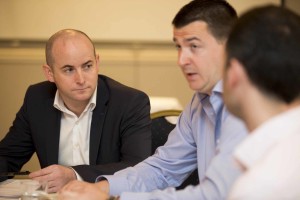
“People do like to go out but they expect a certain standard, so if they’ve got money in your pocket you have to deliver. I’m a big fan of the pub myself”
EL: I still think it’s a very relevant question. The hope is that these young drinkers will eventually migrate to the pub and will find that the pub has something to offer. So the question then is what kind of experience can we have for them – casual dining, premium spirits etc?
So when they get to the age of 25 and they’ve drunk all the vodka in the world, they’ll discover that there’s another drink that tastes slightly different. And trained staff will be able to talk to them about that drink and maybe they’ll have three or four really nice drinks, understanding how these drinks are manufactured, by us serving them really well in nice surroundings in a really nice environment that has an appeal where it’s worth parting with €50 to have that experience.
But you wonder will this drinker ever graduate to the next level of drinking? Will they see the benefit in the experience?
PN: … Rather than just getting hammered?
EL: That’s our challenge as publicans, to make sure that the experience is relevant and that they’re happy to pay for it.
AG: It’s atmosphere, I think, it’s a night out. People want to go out and I think they’ll move to that. I think that when our customers come in they come in for the atmosphere, the entertainment, they’re meeting people.

“The hope is that these young drinkers will eventually migrate to the pub and will find that the pub has something to offer. So the question then is what kind of experience can we have for them?”.
NA: It’s a cycle. You’d hope that at a certain point they’d break from that cycle and migrate back towards good pubs and restaurants. I think it does happen. It’s nothing new that people when they’re young they drink at home, but when they get a little older and wiser they go out on dates and nights out and stuff like that. They join work companies and they see the benefits of having a good night out in a pub.
AG: Certainly, as the economy changes, gets better, more people will go out.
Where next?
PN: So where is the pub going next? What are you looking at and saying to yourself, “I’ve got to put money aside for this”?
NA: You’ve got to keep evolving or you’ll be left behind. When I opened five years ago in the Grafton Lounge, I did a half-baked job, painted it myself and saved up and saved up and did the next job.
And finally I raised the money to do a really good job on The Bridge.
Since I opened up, Dawson Street is absolutely flying – you’ve got some really cool bars – you’ve got Harcourt Street.
The scene is evolving the whole time: if you don’t keep up you’ll absolutely be left behind.
Think of Sophie’s in Harcourt Street. If you went to New York and saw something like that, you’d be blown away by it.
If you don’t stay and keep re-investing, you can really be left behind.
EL: We’ve had our business in Tullamore for 45 years and there’s guys who came in every day at tea-time. You were guaranteed a certain amount of business whether you put on music or had Pilates upstairs, you were still guaranteed a certain level of income. We still have people like that. But unfortunately those customers are literally dying: every year we lose five or six of these guys and that part of the business is getting smaller. And it’s an exceptionally reliable part of the business so at tea-time every evening in Kilbride Street in Tullamore I know there’s going to be about 15 guys there and they’re going to drink three or four pints each. But that business – I can’t really rely on that: I would say that in five or six years’ time I might have none of that.
That’s why we have diversified into the café area; we have another section of our bar which is a lot different. We have refurbished that in the vintage style that seems to be in vogue at the moment. And we have the room upstairs that we use for community events plus live entertainment, parties and all that.
The traditional business of the male customer who might visit the pub five or six times in a week and drink a certain number of pints – that’s gone.
So you have to try and create an experience for the next generation of customers who might not visit as often and have a different requirement for what they expect from a pub – which is a range of products, an informed staff and very comfortable surroundings. Quality needs to be high – and food …
AG: For the fit-out of the bar, we have to constantly change. And we do change it quicker and quicker each time. Currently it’s that ‘retro-industrial’ look but we’ll have to change with the times as it comes. The cycle is getting shorter and shorter.
In drinks, we’ve seen a huge move to the craft beers, massive now compared to what it was. You can even see the big companies bringing in their own craft beer offerings – they’re trying to go down that road with the craft beers.
Also with the liquors, the whiskeys and the gins, it seems to be that people are moving towards higher quality. With the craft beers, they’re not drinking as much but they know what they want.
I suppose we have to change – like the coffee side of our business, we see it as a huge earner in the morning trade and it’s just adapting to it.
In Christ Church we’ve had to adapt: certain elements of it didn’t work and you have to make quick decisions to change. If you don’t, you’re dead in the water.
PN: Noel, you mentioned New York and London. Do you ever go over there with an eye to looking at what’s coming next?
NA: That’s what we did the last time when we were doing a job on The Bridge.
If you go away, your eyes are always open, you’re looking at atmosphere and lighting and stuff and how they do things. If you can just pick up a little trick, it’s key.
I think people should travel and look around them and see what’s coming next. You don’t have to copy something, just take some ideas and bring them back.
It’s our job to excite the customers. You have to have something different to offer them and give them a reason to go to the pub. And you do that by going around and seeing what’s happening. You’ll be left behind if you don’t.
EL: We’ve just completed our last renovation and I worked with a designer and I told him pretty much what I wanted.
To a large extent I was able to use what was current in Dublin and I did it the cheaper way! I went on the internet and looked at the top 20 bars in New York and in London. I worked from pictures and reviews, stuff like that. I took a lot of that material plus what was working in Dublin and put together a brief for the designer and I said, “I want to go down this ‘vintage shabby chic’ second-hand furniture look” which we’ve done and it’s grand.
The only warning is that some of the second-hand furniture is so crap that you only get a few days out of it. You buy a chair for €20 and you think, “This is great, it didn’t cost us much” but the chair is in a heap the next day. You have to be sure that the furniture will stand up to wear, that if someone sits on a table, it’ll still be there!
So I did follow the trends in Dublin and then I looked to New York and London to see what was happening.
What I gathered was that the second-hand vintage look happened about three or four years ago in New York and it’s happening here now. So it will be interesting to see what the next one will be.
NA: It’s the same with the craft beer scene. The craft beers were huge in New York 10 years ago and everybody said it’s coming and it did come with a bang.
A lot of the drinks companies didn’t see it coming and they said it wouldn’t happen. They’re now reacting strongly to it.
That’s the trick and they’re playing it quite cleverly.
PN: Aaron, have you been influenced by New York or London?
AG: I did work in London but I did all the fit-out myself.
My business partner, Ronan, has worked in bars for all of his career. I’ve always been construction and structural engineering. I’ve done a number of bars over the years; the industrial-retro mid-20th Century furniture theme is definitely in fashion.
Having said that, before it was glass and shiny. If you had a break or a scuff on the floor you’d notice it. This new look is quite easy and forgiving. A scratch adds to it.
In terms of where it’s going next, I’m not too sure. Certainly that industrial look, the steel windows with the putty, very much industrial feel at the moment, but as to where it goes next….
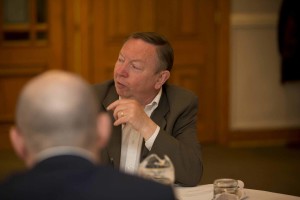
“They’ll go to the nightclub, they’ll get one drink and they’ll go back to somebody’s house for another bottle of spirits. The on-trade is only getting one or two units out of all that and she’s not alone here. Her question to me is: why would we go to a pub?” – Pat Nolan.








